What to do if the subtitle position is wrong on Panasonic Home Theater System?
- Sscott34Sep 2, 2025
Adjust the position. ("Subtitle Position" in Display Menu)
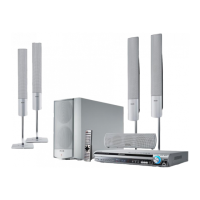
What to do if the subtitle position is wrong on Panasonic Home Theater System?
Adjust the position. ("Subtitle Position" in Display Menu)
Why does my Panasonic Home Theater System turn off automatically?
Your Panasonic Home Theater System might be automatically switching to standby mode because the Sleep timer was working and had reached the set time limit. Insert the AC power supply cord and system cable securely.
What to do if Panasonic Home Theater System shows '/','Cannot display group xx, content xx','This disc may not be played in your region'?
If your Panasonic Home Theater System displays '/', “Cannot display group xx, content xx”, or “This disc may not be played in your region”, the operation is prohibited by the unit or disc, or you are trying to display incompatible contents. Also, select “On” in “On-Screen Messages” in the “Display” tab to display on-screen messages.
What to do if my Panasonic Home Theater System display is dark or shows error messages?
If the display on your Panasonic Home Theater System is dark, try selecting “Bright” in “FL Dimmer” in the “Others” tab. If you see “NOPLAY”, “NODISC”, “F61”, “DVD U11”, “ERROR”, “DVD H??” or “[W]” is flashing, make sure you've inserted a disc that the unit can play, and that it's inserted correctly. Also, if the disc is dirty, wipe it clean. If this does not fix the problem, turn the unit off and then back to ON.
What to do if the Panasonic Home Theater System cannot operate the TV?
If your Panasonic Home Theater System remote cannot operate the TV, press [TV] first to operate the television. Also, check the remote control code for the TV manufacturer.
How to fix noise or distorted sound on Panasonic Home Theater System?
If you're hearing noise, distorted sound, a beat sound, or a low hum during AM broadcasts with your Panasonic Home Theater System, try adjusting the position of the FM or AM antenna. You might also want to use an outdoor antenna, turn the television off or move it away from the unit, or separate the antenna from other cables.
How to fix distorted picture on Panasonic Home Theater System?
If you're experiencing a distorted picture, incorrect picture size, or menu display issues with your Panasonic Home Theater System, ensure the unit is directly connected to the television and not through a video cassette recorder. You can also try adjusting the "TV Aspect" in the "Video" tab, changing the Zoom setting, restoring the zoom ratio to a1.00, turning off the TV’s zoom function, or using other preset aspect ratios or manual adjustment.
| Screen shape | Flat |
|---|---|
| Response time | - ms |
| Display diagonal | 40 \ |
| Display brightness | - cd/m² |
| Display technology | LED |
| Native aspect ratio | 16:9 |
| Display diagonal (metric) | 100 cm |
| Supported graphics resolutions | 1920 x 1080 (HD 1080) |
| Motion interpolation technology | BMR 600 Hz |
| Dynamic contrast ratio marketing name | High Contrast |
| 3D | No |
| Power consumption (average) | - W |
| Tuner type | Analog & digital |
| Analog signal format system | - |
| Digital signal format system | DVB-C, DVB-S2, DVB-T, DVB-T2 |
| Smart modes | Cinema, Dynamic, Game, Personal, Sports, True Cinema |
| Sound modes | Music, Speech, Standard |
| RMS rated power | 20 W |
| Number of speakers | 2 |
| USB 2.0 ports quantity | USB 2.0 ports have a data transmission speed of 480 Mbps, and are backwards compatible with USB 1.1 ports. You can connect all kinds of peripheral devices to them. |
| Ethernet LAN (RJ-45) ports | 1 |
| Common interface Plus (CI+) version | 1.3 |
| USB 3.2 Gen 1 (3.1 Gen 1) Type-A ports quantity | 0 |
| Product color | Black |
| AC input voltage | 220 - 240 V |
| AC input frequency | 50 - 60 Hz |
| Power consumption (off) | 0.3 W |
| Power consumption (standby) | 0.5 W |
| Power consumption (typical) | 46 W |
| Number of OSD languages | 27 |
| Audio formats supported | AAC, FLAC, MP3, WAV, WMA |
| Image formats supported | JPEG |
| Video formats supported | 3GPP, AVI, FLV, HEVC, M4V, MKV, MP4, PS, TS, VOB, VRO, WMV |
| Digital Living Network Alliance (DLNA) specification | DMP, DMR, DMS, DTCP-IP |
| Depth (with stand) | 239 mm |
|---|---|
| Height (with stand) | 569 mm |
| Depth (without stand) | - mm |
| Width (without stand) | 902 mm |
| Weight (without stand) | - g |
Essential safety guidelines for operating the audio system.
Step-by-step instructions for assembling and attaching front speakers to stands.
Guidance on wall-mounting speakers and fitting alternative stands.
Advice on optimal placement of speakers for best sound and stability.
Detailed instructions for connecting all speakers to the main subwoofer unit.
How to connect the system to televisions via VIDEO IN or COMPONENT VIDEO IN terminals.
Instructions for connecting antennas, system cables, and power supply.
How to use the remote control and perform initial system setup.
A detailed overview of all buttons and functions on the remote control and main unit.
Lists playable discs and provides essential handling and caution advice.
Steps for powering on, loading discs, and starting basic playback.
Using the remote for stop, pause, skip, search, and frame-by-frame playback.
Features like disc information, CD sequential play, quick replay, and CM skip.
Functions for zoom ratio, play speed, angle selection, soundtracks, subtitles, and repeat play.
How to create custom playlists or play discs/tracks in random order.
Navigating menus to play JPEG files or HighMAT discs.
How to play items in order, search by title, or play from selected tracks.
Specific navigation for HighMAT discs, RAM discs, and play lists.
Accessing and using the main menu, submenus, and other settings.
Adjusting picture modes, video output, and transfer modes for optimal display.
Configuring audio settings, Dolby Pro Logic II, and sound enhancers.
Settings for DVD playback modes, bit rate display, and GUI options.
System settings for audio language, subtitles, menus, ratings, and TV aspect.
Setting speaker delay times for optimal multi-channel audio synchronization.
How to tune into FM and AM radio stations using automatic or manual methods.
Adjusting the FM tuning step for reception.
Guidance on connecting outdoor antennas for improved radio reception.
Configuring sound effects like Center Focus, Dolby Pro Logic II, Super Surround, and bass enhancement.
Instructions for connecting and operating televisions, VCRs, and tape decks.
How to set the remote control to operate other brands of televisions and VCRs.
Technical details and specifications for the audio system components.
Solutions for power, playback, display, sound, and subtitle problems.
Guidelines for seeking professional service and performing basic maintenance.
Definitions of technical terms used in the manual.
Details on warranty terms, coverage limits, and exclusions for the product.
Information on contacting customer service and ordering replacement parts or accessories.
Advice on safe listening levels and identifying supplied accessories.
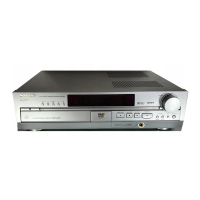
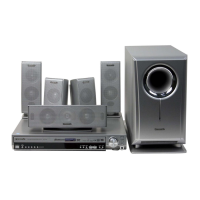

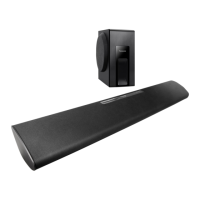

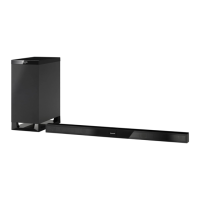

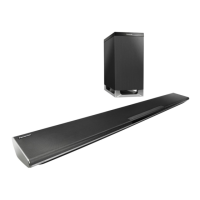
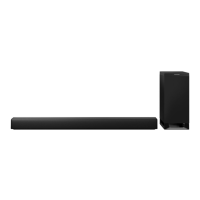
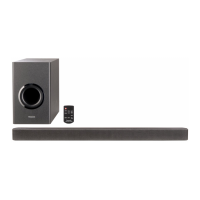
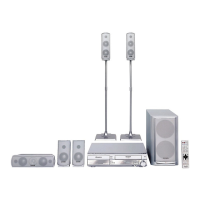

